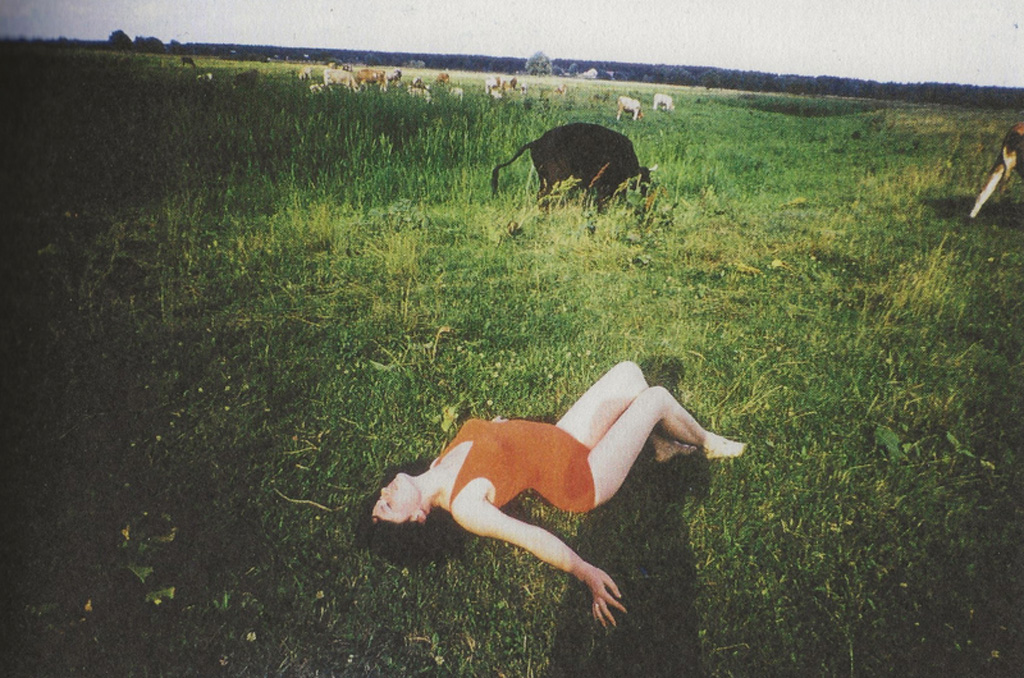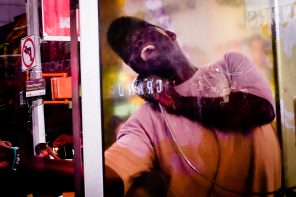Few things are as interesting when it comes to artists than watching them discover their true work, what they’re supposed to do, who they’re supposed to be. When I first moved to New York City many moons ago I used to plop myself in front of Les Demoiselles d’Avignon at MoMA as often as I could, watching in one painting Picasso discover cubism. Likewise, the first Beatles LP I bought was “Beatles 65” (not their best, the U.S. bastardization of “Beatles for Sale”), but notable because John Lennon had just heard Bob Dylan (and been turned on to pot by him on Sixth Avenue) and made a leap in his songwriting to the personal, and powerfully sad, “I’m a Loser” and “No Reply.”
In the same spirit we now have Boris Mikhailov’s “Suzi et Cetera (Part 2),” early photos from the 1960s to the ’70s, in which Mikhailov discovers not only the joys of color photography in general, but the stirrings of what he wants to do with it, his own style, his own way of taking on the ridiculousness and horror of being a citizen of the Soviet Union. (Ridiculousness and horror, spread these days even to democratic nations, it seems.)
For Mikhailov the photos in “Suzi” are “like a capsule containing the embryo of all his following works and explorations,” as a small booklet enclosed with the book tells us. (They remind me most of his later Red Series, casual shots of Soviet life with small curiosities captured; more on this later.) One of the fascinating aspects of the book is not only that Mikhailov is discovering his own artfulness, he and all of the Soviet Union are discovering color film, which became widely available there only in the mid-’60s. As the included essay, by Kateryna Filyuk, a curator in Kiev, tells us, “color photography was taken out of the pathetic-official, the collective, and came into the private, almost intimate sphere, at the same point in time when the consciousness of the Soviet person began to shift.” I take that to mean that for a budding artist like Mikhailov, this new color film came at just the time people were discovering a true personal life outside the rigid Communist system. And what could be more exciting for him than to record this new freedom, in photos of private—and previously hidden and forbidden—experiences.
So what do we get? A lot of nudes, pretty girl nudes, plump girl nudes, dumpy guy nudes, and one crazy indoor shot of a dude wearing only his underpants with a bright orange pencil sticking out of his belly button, a woman in an equally orange bathing suit covering her face with her hands, but still sneaking a peek … a curiously subversive photo.
Yeah, people were people, even back then in the U.S.S.R. Raw, up for anything, goofy, drunk, sometimes serious … people. And photos that … well, as a quote by a visitor to the show that inspires the book tells us, “You could only take [photos] like this in the U.S.S.R.”
And what a range of shots there are. Along with the copious nudes (many of people cavorting out of doors), there are shots of all manner of regular folk. Here’s one: two scarf-clad women in heavy blue overcoats dancing together on gray stone a great distance from an open-air band shell. Nothing to distinguish this picture at all. Indeed, it’s one somebody might take of their own mother and her friend, then throw away because it’s pretty boring.
Except it’s not. For one, I’m assuming this isn’t a photo of any of Mikhailov’s relatives, not that I guess it really matters. Since, for two, the photo has an intriguingly open sense of space, the women balanced in a dime-store version of a “decisive moment.” There’s another photo many pages on of another two women in heavy coats and scarves, this time nearly lost in the oppressive emptiness of a Soviet apartment complex. More common people dealing with Soviet life. Just to make sure we know where we are there’s a subtly ugly/beautiful shot of a hammer and sickle sculpture above a car’s rooftop with a smokestack in the background.
Sometimes Mikhailov goes for the purely commonplace in a close-up fashion that makes the photos anything but common. For instance, a brilliant red purse before tall stalks of green grass, and a quite lovely/ominous photo of a purple cabbage sliced down the middle (I trust ready to be made into borscht). Regular life glimpsed extraordinarily.
Then the photos get stranger. A woman fully clothed and lying on her side amidst a burning field, flames nearly surrounding her. Two close-up women sticking their tongues out at each other. A sculpted dummy hand, nails a ravishing red, sitting by itself on the arm of a broken wooden chair. That guy with the pencil protruding from his belly button.
And finally subversive: Mostly the outdoor nudes, a corpulent woman with a fur stole over her bare breasts and pudenda, supine on an Oriental carpet beside a river. A woman in a park, in a dress, but with her legs splayed open. Another naked woman indoors on a mat, posed like an Ingres nude. A woman urinating behind a storage shed. A curly-haired naked man squat with his legs apart, a female head covering his groin….
So here’s the question: how much were regular Soviet citizens acting this way before they had color film to take pictures of themselves with? Sounds like a flip question but it’s not. In the Instagram age we live in now we know all kinds of behavior has changed because of social media force, as in, I don’t really want to go to the Himalayas and probably die climbing Mount Everest, but I really can’t go on without spreading around a selfie of me summiting the top. Or, I don’t really want to wait in line for an hour and twenty minutes just to get a kimchi taco (with edible flowers!), but how can I face myself if a photo of me smacking my lips into it isn’t social-media’d around the world?
So here we have Soviet Ukraine in the ’60s. Were people already throwing themselves around outside nude as can be? Eager to document perverse acts of the kind that presumably in Stalinist days would send them to a work camp because that was the way things went down? Or are all these crazy things people are doing the things they’re doing because now there are cameras out there, and their acts can be photographed and shared? Or is it Mikhailov enticing them to disport themselves in this way?
My bet’s on the latter, since that’s what artists do. They move the world around them at least as powerfully as a new iPhone app (and with far more depth and soul and meaning; I’m looking at you, TikTok). That’s why we love art.
And why we have to celebrate Boris Mikhailov’s new book. Photo after photo expressing the freedom and thrill of a color camera finally in the populace’s hands (perhaps a Smena or a Chaika or a Zenit; here’s a link to the 10 Most Celebrated Vintage Soviet Cameras), along with the Khrushchev thaw to help them make the most of it. And Mikhailov himself finding those casual, barely noticed moments—a man on a rainy street stooped over picking up something from the sidewalk, a brown-and-white cow by the side of a path, a woman casually picking her teeth, a boy’s head popping up in the rear window of a bus in a snow-covered parking lot—those singular expressive photos that in the right hands will always conjure up a true world, perhaps lost to history, but fascinating for us forevermore.
Suzi et Cetera (part 2) by Boris Mikhailov can be purchased here.
Robert Dunn is a writer, photographer, and teacher. His latest novel is Savage Joy, inspired by his first years in NYC and working at The New Yorker magazine. His photobooks OWS, Angel Parade, Carnival of Souls, and New York Street are in the permanent collection of the libraries of the Museum of Modern Art and the International Center of Photograph (more info on Dunn’s own photobooks here; prints of his work can be ordered here, follow his instagram here). Dunn also teaches a course called “Writing the Photobook” at the New School University in New York City.






